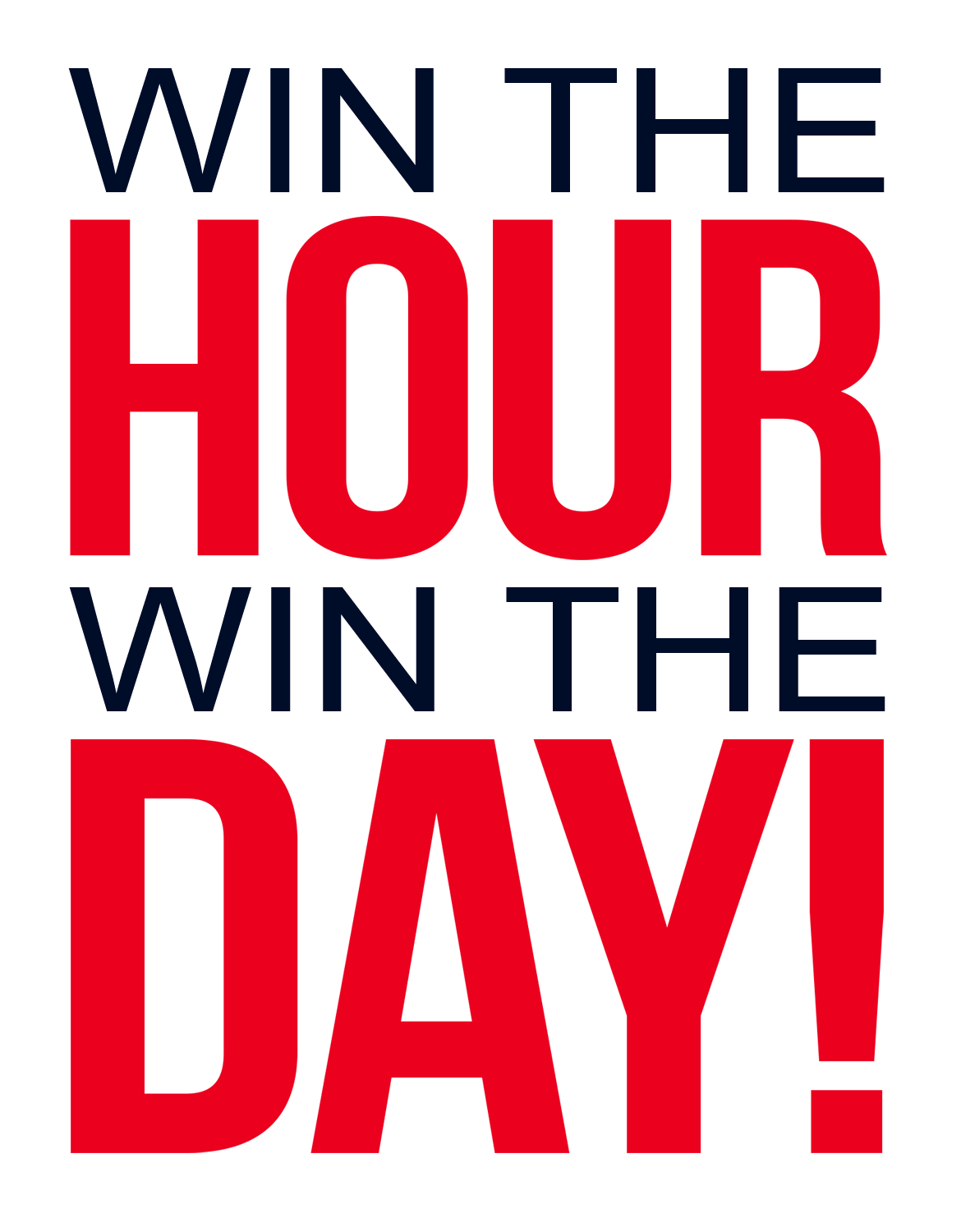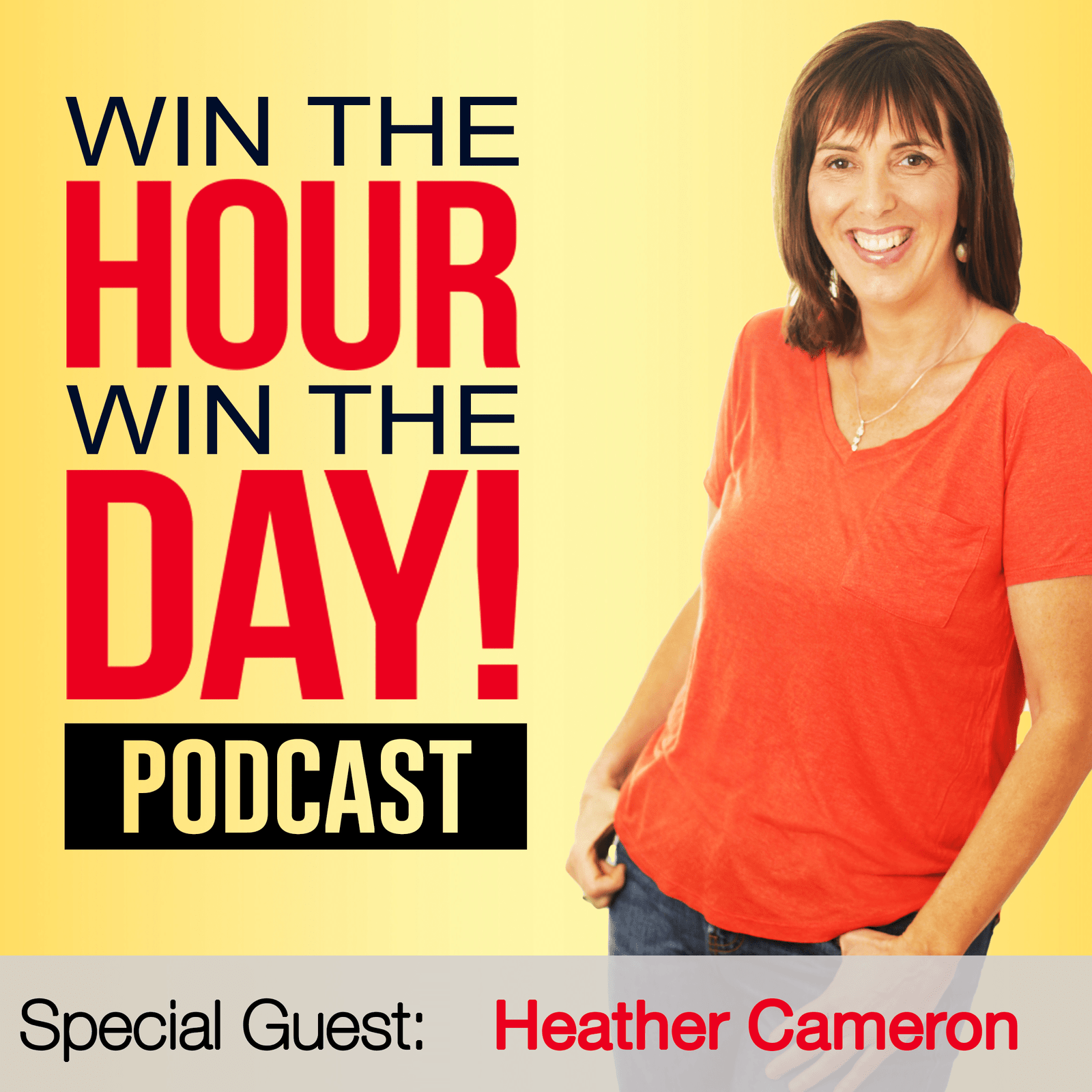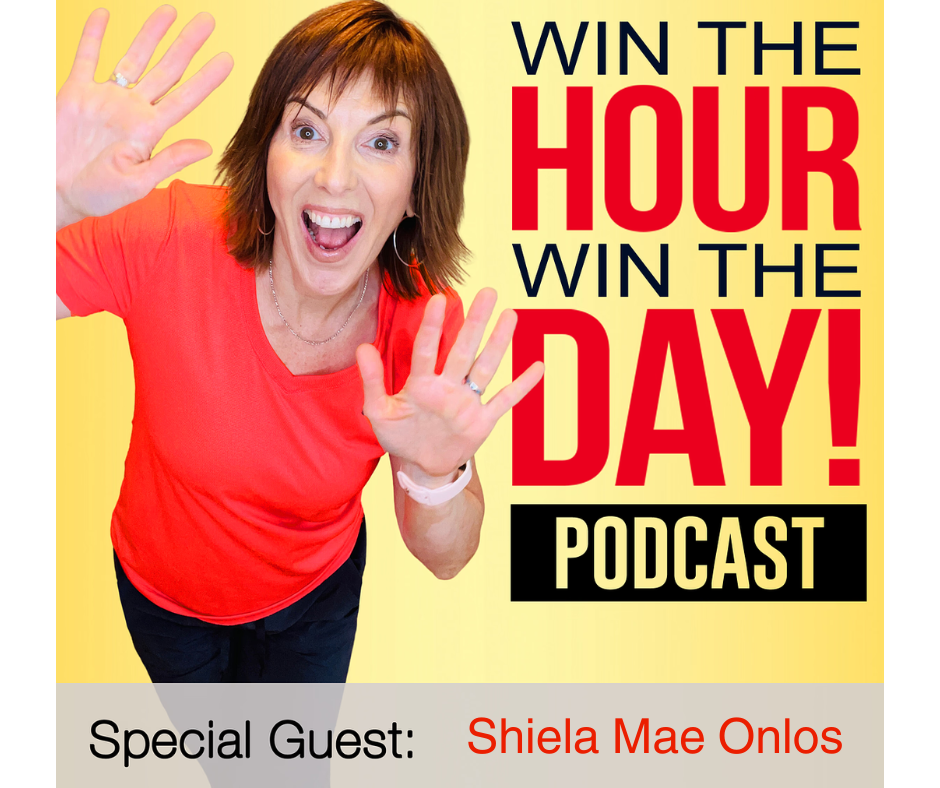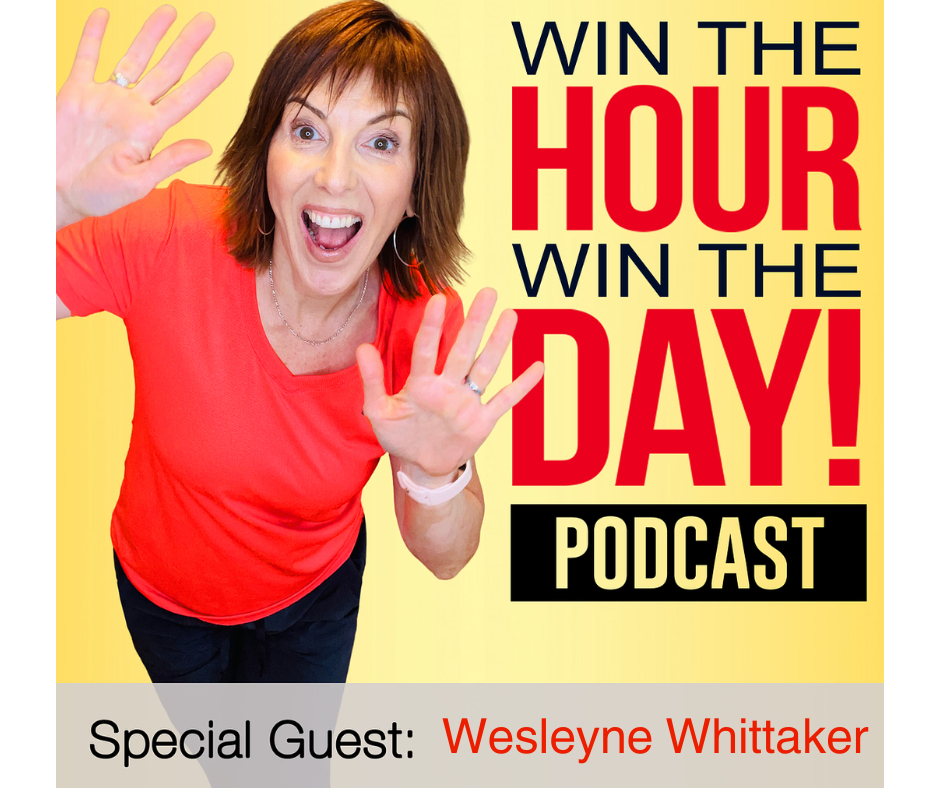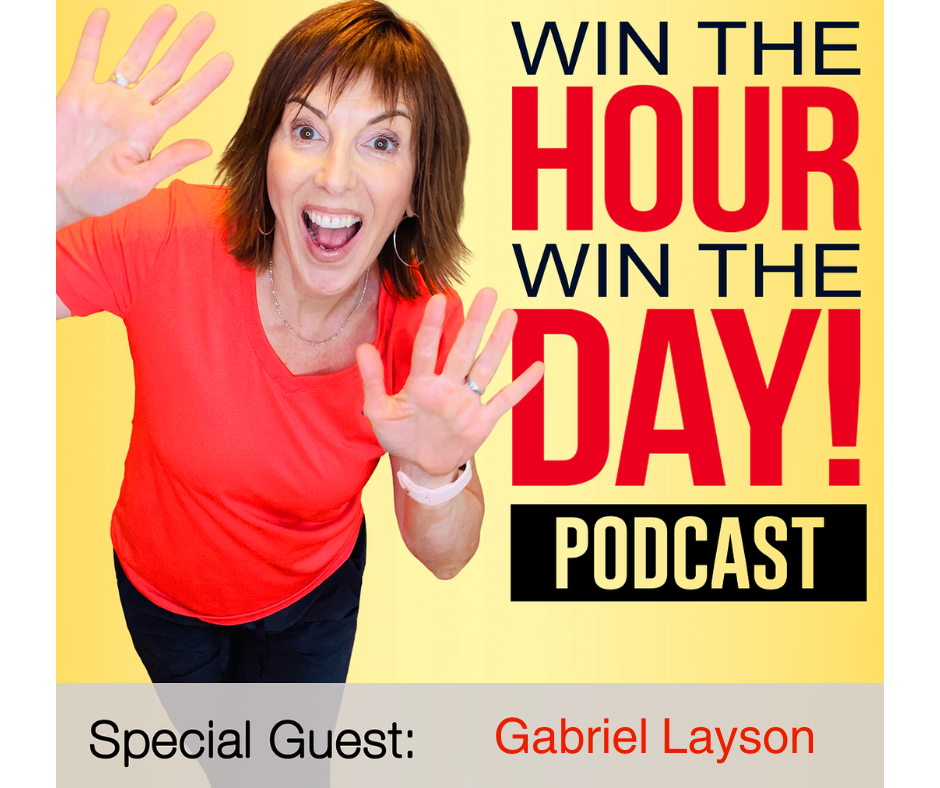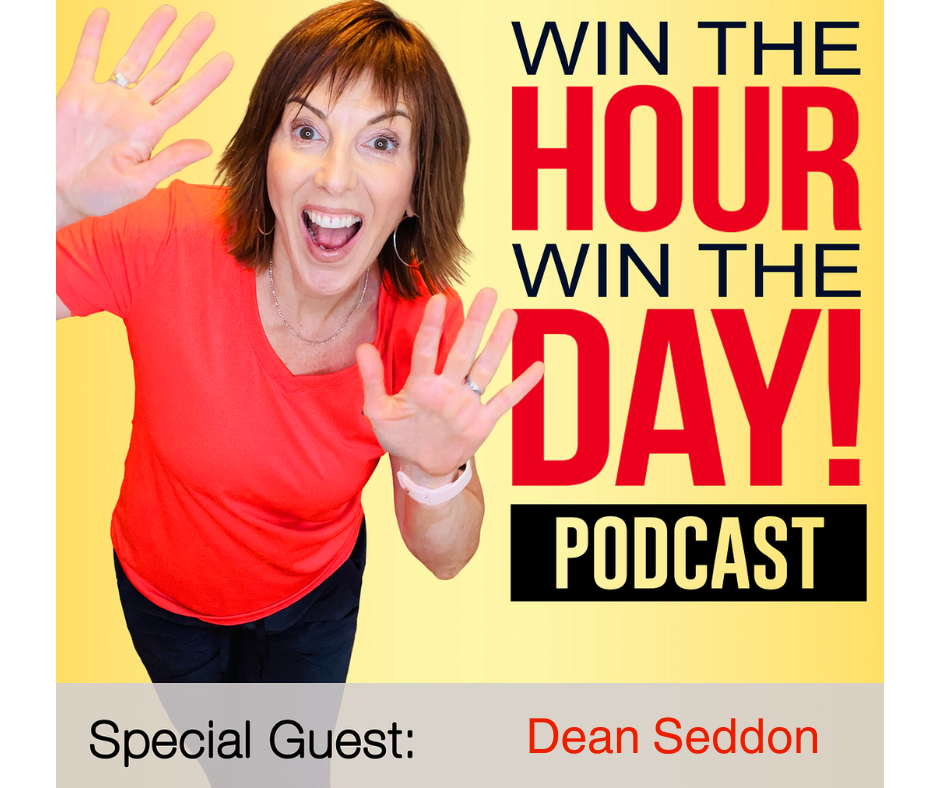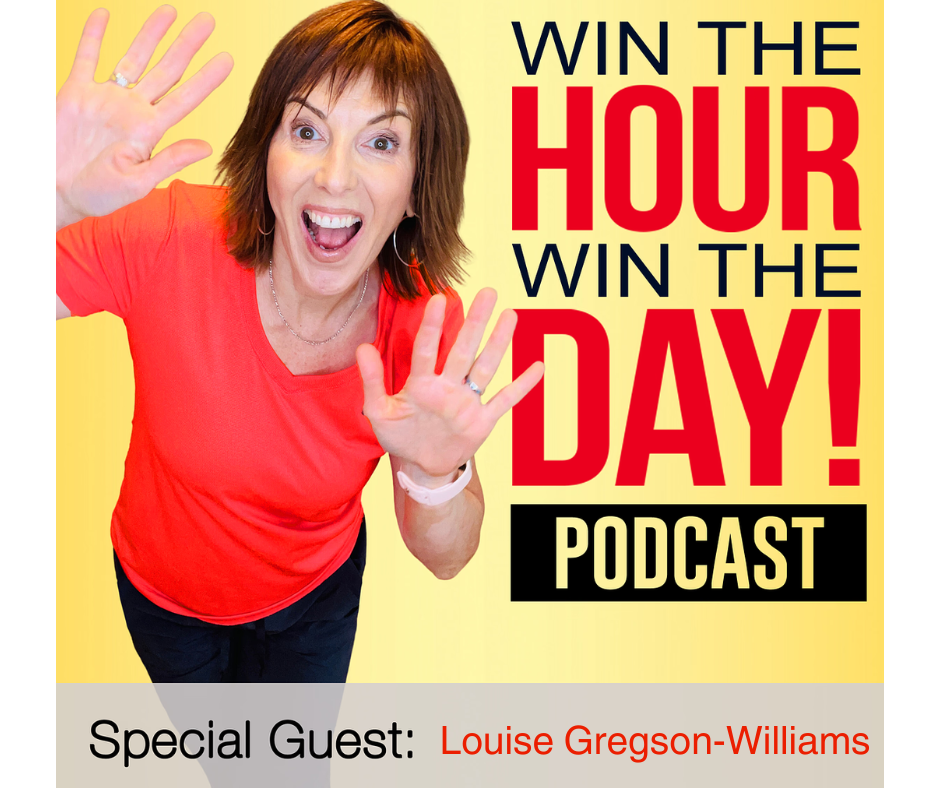Episode Summary
Heather Cameron talks to us about The 7 Key Accelerators that grow your business. We dive into the world of traffic, leads, and conversions to name a few. But here’s the best part, Heather makes it simple and interesting not like the other stuff out there!
Learn:
-why you shouldn’t worry about doubling your sales
-micro steps you can take to dramatically increase your conversions.
-how to create more leads, easily with minimal effort
And so much more!
Win The Hour, Win The Day Winners Circle
https://winthehourwintheday.com/winners-circle-masterclass
Win The Hour, Win The Day! www.winthehourwintheday.com
Podcast: Win The Hour, Win The Day Podcast
Facebook: https://www.facebook.com/winthehourwintheday/
LinkedIn: https://www.linkedin.com/company/win-the-hour-win-the-day-podcast
You can find Heather Cameron at:
Website: https://igniteyourmarket.com/
Facebook: https://www.facebook.com/groups/BoldandSuccessful/
Email: hcameron@horizon-insights.com
LinkedIn: https://www.linkedin.com/in/cameronheather/
Win The Hour Win The Day
https://winthehourwintheday.com
Heather Cameron Podcast Transcription
START[00:11:38]Kris Ward: Hey, everyone. Welcome to another episode of the Win The Hour, Win The Day Podcast. I am your host, Kris Ward. And today we have Heather Cameron in the house. All right. Heather is a really a getting business strategist and business coach, and she is really
[00:11:54] passionate about getting business. Now I’m not even going to tell you what we’re going to dive into because at first glance it kind of doesn’t sound so interesting, but it really is. All right. It really is. Okay. So bear with me. Cause I kinda put her through the ringer on this one. I’m like, Ooh, let’s see how this goes, Heather. Okay, Heather. Welcome to the show.
[00:12:15]Heather Cameron: Thank you. Thank you for having me on the show and let’s try and make this interesting.
[00:12:19]Kris Ward: Okay. So it is interesting. Heather’s going to talk to us about the seven key accelerators for growing your business. Now, is it okay if I skim over them really quickly, Heather? Okay. So what you’re talking about here, the seven key accelerators for growing your businesses is traffic leads, conversions, average price, average number per items, frequency and retention, correct?
[00:12:45]Heather Cameron: Correct.
[00:12:46]Kris Ward: Okay. So added glance, that seems heavy handed, but I do think like when you’re entrepreneurial, like, oh, head down, don’t just try to get to the Google go right. I think what happens is when you say those out loud, I’m like, of course we know that traffic is everything, leads. Okay. And then conversions, we know that we know that we’ve read the books, we know that, but I think it gets lost in the shuffle and swept under the carpet a lot.
[00:13:13] And so then you’d sort of go where, you know, you can’t improve what you don’t measure. And I’m ashamed to tell you Heather, because for many years when my business was new, you’re just so desperate to get new sales that all you think about is like, okay, I need to get new sales, but you don’t break down
[00:13:28] what are your sales conversions? Or you’re just hungry for the kill. So you leave the cave, go running into the wild, just throwing your arrows at anything. And, you know, it took me a long time to be keeping track of this and seeing where this goes for us. So shame on me, but I can’t be the only one. Right?
[00:13:45]Heather Cameron: No. You’re not the only one.
[00:13:46]Kris Ward: So let’s talk about it. Where do we go wrong?
[00:13:50]Heather Cameron: Well, and the beauty of that, one of the things we go wrong is we could put so much pressure on, we want to double our income. We want to triple our income. You know, you hear a lot about six times your income, seven times your income, but what does that actually mean?
[00:13:59] That’s a big number and the beauty of these numbers is that when you start to track them, you don’t need to track them in a heavy handed way. You can track them in a light way, but the beauty is that you only need to tweak each one by 10 to 15% to double your income. That’s a lot.
[00:14:20]Kris Ward: Hold on. I’m going to interrupt you a lot because you’re really talking about math, which in my brain, when you it’s like they, I don’t know, there’s an open window and they just let the breeze go in and out that side of the brain that has math. So I think you’re right. As bad as I am at math, I think we just always hear those numbers about growing your business, doubling your income, and we don’t break down how to do that. So it’s not this big, crazy beast. If we just tweak every little number.
[00:14:47]Heather Cameron: We tweak every little number between 10 and 15%. You’ll double your income in a year if you treat them a little more. And so when you think about it, and one of the best examples, this is McDonald’s, would you like fries with that?
[00:14:57] They’re not expecting everyone to buy fries with that. They’re expecting maybe 10% of people to buy fries with that. Right. That’s a really good example of, and that average numbers of items per transaction, right? So they’re trying to get you to buy one more item with that transaction. That’s what, with fries like that is all about. And so they’re not aiming to get every single person to buy fries, just a small percentage of them.
[00:15:20]Kris Ward: Okay. So for us though, where a lot of us have services, not so much with, you know, a suite of products, that would we look at that, like our value ladder, we have different entry points into our processes?
[00:15:32]Heather Cameron: It could be a value ladder, or it could be that that’s just one of the ones that you don’t put as much emphasis on.
[00:15:36] Right. So it’s really figuring out which one it is that you want. So if you start with the first one traffic, how do you bring in, how do you make 10% of people more aware of what you do? So for example, even with an example of a podcast, if you have a podcast and you have a thousand listeners, let’s say, how do you get an extra 10%, an extra a hundred listeners, right?
[00:15:57] That’s a lot easier to get your mind wrapped around. How do you bring in a hundred listeners then? How do you bring in double your listening audience?
[00:16:06]Kris Ward: Okay. I’m already excited about this. Okay. That does, that is far more digestible, right? It really is. It’s kind of like, I always compare everything to weight loss, cause everybody’s always wanting to lose five pounds at some point in their life.
[00:16:18] So that’s kind of like saying, you know, what would I say? I have a relative right now and going through a little bit of a transformation he’s trying to lose weight. And so I keep telling him, you just need to tweak it. So we get them from potato chips to popcorn now to air popcorn and all of a sudden the calories we didn’t say go from here to eat and kale chips.
[00:16:34] Right? So all of a sudden he’s like, oh my gosh, I love this air popcorn. And it took us two or three steps to get there, but it’s like a whole bunch of calories they’re saving. So it’s really just tweaking all these things.
[00:16:45]Heather Cameron: It’s tweaking them all. And if you take, so you’re looking at seven things that you want to tweak and you might not be able to tweak all of them.
[00:16:52] Right. Okay. And that’s what you have to kind of, for people who have something that’s a set price, maybe they can’t add. So they can’t tweak that one. So you do the other ones a little bit more, but it’s still focused down on seven key things and you’re not trying to double anything. You’re just trying to tweak things in each part of your customer journey. Right? Okay. Whatever term you use.
[00:17:13]Kris Ward: Yeah, so value ladder, I’m sure you guys know, but I’ll pass it out long anyway, just different entry points. Like for us, we now started a masterclass it’s, you know, it’s about a third of the price of if you’re doing a one-on-one with us and then there’s one-on-one and then there’s what we have groups with two or three people, but the masterclass is bigger.
[00:17:30] So there’s different entry points that you can work with us in the value ladder of how much access and how much money costs or investment, not cost investment, but so can I ask you this, Heather? So I do have a little spreadsheet where I’ll say, okay, here’s who I met. And, you know, we, we had a sales call and did they convert. Now should, so that’s just leads going into conversions. Should I be keeping track of other things on this as well? Or am I getting ahead of myself?
[00:17:59]Heather Cameron: No, you should. I mean, one definitely keeping track of all of them. So if you’re keeping track of traffic, right. And depending you might be looking at traffic at different sources, right? So how many people are landing on your website?
If you’re using social media, how many people are interacting? Traffic can be a little bit different per source, but..
[00:18:18]Kris Ward: Yeah, we do that. We do keep track of interactions on social media. We have a stats meeting every week. So we do keep track of the podcast. We do keep track of social media. So this is really important.
[00:18:26] What you just said. Forgive me for interrupting. I want to unpack this. I was thinking now. Tunnel vision on the sales, but traffic is traffic. So don’t just think, okay. I was thinking about traffic at a sales meeting. How many sales meetings did I have on this? No it’s traffic for everything, right?
[00:18:42]Heather Cameron: Yeah. So you can bring in 10% more in all of your traffic sources, right. That is going to ripple through all your numbers. So that would be the first one to look at. You know, there are so many ways to increase your traffic. When you think about it strategically and doing something just 10% more is not as difficult as trying to double your traffic. Right. So traffic would be the first one and then leads. When does somebody become a lead?
[00:19:05] And that’s a definition that you would have per traffic. So when somebody is on your podcast and listened to your podcast, when did it become a lead? When did they become a prospect?What that point that you measure? And then how can you increase that by 10%?
[00:19:20]Kris Ward: So do I measure that or do I know, like I will put, let’s say I did have a sales call with them and I would say, okay, Heather, I would say, okay, I met her as I was hosting a podcast, or I was guesting in a podcast.
[00:19:34] So I’m not sure if I’m… I guess I’m measuring that, but I’m not keeping track of that at the end of the month. Maybe I should be looking at it, I do have a spreadsheet and its there, but maybe I should be tallying it up.
[00:19:45]Heather Cameron: But if you’re a guest on a podcast, do you give them an invitation to download a freebie? Let’s say. Do you have an opt-in? So then that could be your measurement of lead. Anybody who opt in now becomes a lead.
[00:19:54]Kris Ward: Okay, so, all right. I’m still getting stuck on the sales call. So what we’re saying is this is everything, we’re increasing everything, which we do. We’re always looking at, we’re looking at our conversions and our stats meeting every week.
[00:20:04] Okay. What are our opt-ins, what have we increased on that? Have we increased on this? We’re constantly looking at increasing, but I think what happens is when we start talking about money, maybe it’s just me. When we start talking about doubling your income, I go right to sales, I think. Okay. Here’s the sales meeting.
Here’s what we’re doing. And then that is, that’s just the outcome or one aspect of a much bigger food chain kind of deal.
[00:20:26]Heather Cameron: Exactly. And that’s exactly it. It’s the chain of how you move somebody’s customer journey. Right. So if you’re just focusing on doubling your income and closing more sales calls, well, really, you have to book more sales calls, right?
[00:20:39] You need more leads and to get more leads. You need more traffic, right? And so if you focus on really doubling your conversions on your sales course, that’s a lot of pressure on just that one part of your system, which you can get any mind. It can really stall an entrepreneur. They can get in their heads.
[00:20:54] I have clients though, who one of their problems is, they’re great at converting. Right. They, they actually convert their sales calls at like 80%, but they don’t have enough people coming into the calls that they can work as hard as they can to make better at converting calls, but they really need to increase their traffic.
They really need to focus on growing their traffic, which would then ripple through the system that they have.
[00:21:14]Kris Ward: Right. And I think if you spell it out, we all know. Or we know it sometimes. I like to say, I forgot I knew that. So we know that traffic is important and we know that because, oh, if I can get in front of more people, we know that.
[00:21:25] But I do think it gets to you once, cause you’ve had to redirect me at least four times already. Because once you get into the sales head space, we’re very limited in narrow-focused or maybe it’s just me. I don’t know. I can’t be the only one. So he gets very limited and narrowly focused on the sale and you see that as the beginning, middle and end.
And that’s just one component, almost like a widget going through a great big factory coming out the other end. There’s many things that happened to that widget through the process.
[00:21:54]Heather Cameron: Exactly. And if you only focus on the sales closing the sales, you’re putting, you’re doing a lot of work on only one part of the system, less work on all parts of the system.
[00:22:04] Okay. And some of it can be really simple. So let’s say for example, somebody, one of your listeners is using an opt-in page. This is a big one. People who go to your opt-in page for a free offer. So they come from you being a guest on a podcast and they go to your opt-in page. They’re already engaged, right?
[00:22:20] So that particular page should convert at a high number. If it’s not. Then what little tweaks can you do to increase that number? Right. And so simple things like that, asking yourself those questions about each part of your chain is how you’re going to exponentially grow your business. Not just focusing on one part, which is what a lot of people do.
[00:22:40] Some people only focus on traffic, right? I need more traffic. I got to get more traffic and then people come in and they just fall off the wagon because they’re not focusing on getting them to convert, to actual either sales calls or however they sell their product or service. Right. I think you are like, most of us, we focus on one thing, but we all choose different parts to focus on.
[00:23:01]Kris Ward: And get lost in it. Yeah.
[00:23:02]Heather Cameron: And often it’s either the one where the best at, or the one where the most, we want to become the best at. Right.
[00:23:09]Kris Ward: Okay. Okay. All right. So then we go to the average price and average.. Are these paired together, average price, average number of items?
[00:23:18]Heather Cameron: It can be different. So the average price means, are you charging enough for your products and services?
[00:23:22] A lot of service-based people don’t charge enough. So how can you increase your price by 10%? Is it making sense? Are you still going to be, what do you need to add to it? I mean, he just gave a great example. Let’s say, in your new mastermind? If six months from now or eight months from now, you want to increase it by 10%.
[00:23:39] Do you need to add some value to it? What does that look like? So how can you increase your price by 10%? And the average transaction is the number of items people buy in the same transaction. So even with your mastermind, maybe you offer your mastermind and you offer some people the VIP option.
[00:23:56] Right. So you’re not expecting everybody to buy the VIP option. Right? The VIP option is one out of 10 buys. You can increase the amount of transactions by 10%, the amount of items in the cart, right? So a VIP option is a great way. If you’re selling online services or any type of services, having your main product or service, whether it’s a program or whatever you’re doing.
And then out of the VIP option, you’re not trying to get everybody to buy the VIP option. You really only need one in 10 people to buy the VIP.
[00:24:27]Kris Ward: Right. Okay. So for us, I threw in a lot of bonuses that I still could have, ’cause it’s to do the masterclass. So there are bonuses because it’s new that we won’t have six months from now.
So there’s six months from now. Those could be VIP options or I could still have those bonuses and then up at for VIP option
[00:24:43]Heather Cameron: Exactly. Right.
[00:24:45]Kris Ward: And I know that, you know what, you know, sometimes, you know stuff, you’re like, oh, I buy the VIP options and other places, I know that. But you forget when it’s you. You’re like, uugh.
[00:24:56]Heather Cameron: I have a mentor that I work with. When she does like a free challenge or she does anything like that. She always offers a VIP option. It’s amazing how many people buy the VIP option. So even on a $27 product, she will offer a VIP option and people will buy the VIP option. And all she’s doing is putting more things in the cart.
[00:25:15] And when we’re sort of in space, we think we can’t do that, but we absolutely can do it. Right. And sometimes VIP options are so smart, they’re not even here doing the work. She pays somebody else to do the work for that VIP option. Right. So. And if you were going to teach somebody how to do a podcast, you could have a VIP option where they work.
[00:25:33] They get a special session with your podcast manager. Right, right. You do things like that. So just adding a VIP option, puts another item in the basket. And if you sell products, products, you can do, you know, people do the buy one, get one free or supersize it with fries or things like that. How can you put one more thing in the box?
[00:25:50]Kris Ward: Right. And I was doing that, but I just called them bonuses. So instead of giving seven bonuses, I can give four or five and then you have two free VIP options. All right. My head is exploding all over my desk here. All right. I’m like, oh, he’s leaving money on the table. And it’s so funny because there’s so many things that I transfer, like, you know, I’ll see something that Amazon does.
[00:26:12] Like I would tell my clients, I talk to them about staying in communication with years ago. I started, if I had, let’s see, you are a new client, we send out videos over a drip campaign. Then I was doing this on me for any bales, because what I was experiencing was, I remember back in the day, this sounds like 200 years ago, kids.
[00:26:29] Yeah. You know, 10, 12 years ago I was buying a book and then Amazon would say, okay, the books on the way. And the books are, the books that. And I realized they’re keeping me really emotionally engaged over a $20 book. So I thought when people were paying for my services and paying more, I should keep them engaged.
[00:26:43] If they’re keeping me engaged for 20 bucks, I should do that. And so sometimes I can really see the transference and say, oh, I’m transferring to this, and it’s the same concept and I’m all proud of Kris. And look at me, I think I’m special for a moment. And then other times you look at something that’s so like mind new, and you’re like, I, the old, as old as time, we all know that upselling, you know, with the fries.
[00:27:06] And we do know the VIP option, which is getting ridiculous when you travel, when we’re back to travel, you’re in a plane and I’m always waiting for them to say, Oh, I’m sorry. Ma’am you didn’t buy oxygen with this seat so you won’t get any, but that’s the VIP option, right? So there’s all this craziness that they’re now adding like, oh, if you want to, very expensive peanuts, that’s the VIP option. Right. So, okay, awesome. So that is a really good tip. Alright, let’s go for it
[00:27:27]Heather Cameron: Not that all the time. If you ever look, Amazon’s a great example. If you ever buy something, they always show you that people bought this plus this equals that, right. They’re always showing you that upsell. Even if they’re not pushing it on you, they’re just saying somebody bought this cartridge for the printer.
[00:27:46] Well, they also bought paper at the same time. Right. And so they’re putting things in your mind to think about those options. So it works for products and services about how you can, cause people like to be VIP. They like to feel like they’re getting a deal. Right. So even with services, you can do that.
[00:28:01]Kris Ward: Yeah, you’re right. You’re right when you’re right. You’re right. Okay. Let’s continue. Heather, let’s continue this enlightening game of where I’m leaving money on the table
[00:28:12]Heather Cameron: Or the opportunities to make more money next time.
[00:28:15]Kris Ward: Okay. All right.
[00:28:18]Heather Cameron:On the more positive side of that.
[00:28:19]Kris Ward: Yes. Yes. Thank you. Okay. So then we go to frequency.
[00:28:24]Heather Cameron: Frequency is really just getting people to buy more often. So if you’re, and I mean, a mastermind’s a great example. So often when we do masterminds or it’s a continuing masterclass, You’re asking people to buy every month. Right? So sometimes. You’re asking them to buy more frequently or how do you go back to your existing customers and give them an offer?
[00:28:45] So they buy more frequently. So thinking about it’s that it’s that 80-20 rule too, you know, 80% of your income can come from 20% of your customers. So really frequency is if your customers buy from you every six months, let’s say as an example, how can you get them to buy from you every five months we’re getting, you know, bring them in.
[00:29:02] What can you do? And a lot of people lose focus. I’ve seen it often in the service industry where, you know, we. put out a program and somebody signs up for a two month program. What do you offer them next? What’s that frequency of buying? So how do you get them to buy more frequently from you? Right.
[00:29:21]Kris Ward: And one of my things though is when I’m working with coaching clients, a group coaching, or one-on-one, I’m just such a proponent of like, there’s no add-ons, I give all a lot.
There’s a lot of value in there. So then, you know, there is no add on during that. And then I guess, They get so much bang for their buck that when they graduate from working with us, it’s a little while before, you know, they’re ready to jump back into it. But I guess after they graduate, I could have, you know, little products or services to continue that. Okay.
[00:29:57]Heather Cameron: The inevitable, right. I have a client who’s a website designer. So what she sells is a service package so that she can kind of do that check-in with them once a month to make sure that their website’s working. There’s no issues. She offers a six month review because the website’s changed.
[00:30:13] So how can you do, you know, I mean, I’ve had one-on-one clients that really, after they’ve gone off on their own. Kind of go off track, right? So how do you bring them back on track? So really that’s rich retention and frequency are similar in the sense that retention is how you keep them coming back.
[00:30:33] And frequency is how do you get them to come more often? So, you know, using coffee industry, how did they get you to come back, and retain you? They’ll give you a free coffee when you buy X amount of coffee. It’s another example of retention and frequency. You’re going to come back. If you have a coffee card to fill out in the old days where they stamped it, now they don’t stamp it.
[00:30:51] It made you come back more, right. McDonald’s is a great expert of that, where they have a little, you know, on the cup, you have a thing that you can tear off and you put. Right. Yeah. That’s all about retention and frequency. Okay.
[00:31:04]Kris Ward: Yeah, absolutely. Okay. Awesome. All right. And so though, do you feel they go hand in hand- retention and frequency?
[00:31:11]Heather Cameron: I think they can, they’re slightly different in their mindset, but they do go hand in hand, to me they’re about maintaining your existing customers, right? It’s about addressing your existing customers. And so there is a different flavor to them. Because one is offering them more. Because you could retain a customer for three or four years using your example as one-on-one coaches, you could retain them for three or four years, but maybe they only buy once a year.
[00:31:33] Well, how can you get them to buy, once every eight months? How can you pull them in and buy more frequently? That’s what frequency is about. How can you get them to buy more often? And then retention is how long can you keep them as a client?
[00:31:47]Kris Ward: Yeah, I think for me, I get my brain stuck on that.
[00:31:51] Whereas if you’re a coaching client you’re paying monthly, so there is a retention. So like, let’s say we hope you stay with us for a year or two or whatever. Then I don’t see anywhere in there where I could add on something because they’re already paying me a monthly fee.
[00:32:07]Heather Cameron: And you don’t, so you don’t necessarily need that frequency, right?
[00:32:10]Kris Ward: Right. Okay.
[00:32:11]Heather Cameron: It’s not all of your products and services. You want to look at these and say, does this make sense for me? Right? Because on your…I know I’ve had one-on-one coaching clients who then let’s say I’m releasing a small training program. May still buy that because it fits into what they’re doing or it could be thrown in. It just depends how you package things up.
[00:32:32]Kris Ward: Right. I think what’s happening is we’re going back to the beginning where I get structure, which is a beautiful thing when it doesn’t limit you. So what’s happening is I’m seeing these seven things and then I’m like you said, in the beginning, I’m waiting them equally and saying, oh, it must go through all these things.
[00:32:47] Here’s my one thing. It must go through all these seven steps, these seven key accelerators, but it may not be a good fit. These are seven components that will allow me to bring in more revenue and grow my business. But one step, you know, traffic maybe where I put 20% and then, you know, adding items, maybe I put 5% percent. Right. Okay. So don’t get stuck in the process of it.
[00:33:10]Heather Cameron: Don’t get like if you’re not. Generally speaking, most people aren’t thinking about any of these steps in a homeless pattern. Right. So if you spent down and you just think about each one and say, well, okay, retention, I’m God, I know how I’m going to retain my clients, but what’s your retention strategy once one of your six month or a year long client ends, what can you offer them in a maintainance.
[00:33:29] I am not sure that’s the right word, but an ongoing support. What can you offer them? So that would be focused on that retention component. You’re already doing frequency because you’re working with them for X amount of time. So that’s not something you’re going to focus on your one-on-one, but it might be something that you focus another offer on.
[00:33:45] If somebody offers a training program, they do like a six week training program, a six week course. Then what can you do about frequency? So I know someone who does this brilliantly, she has over the year, she has like six offers. And she continually promotes the next offer in the offer that she’s already doing.
[00:34:07] Right. So she’s focused on this retention on this frequency, getting them to buy all of her logically incrementing offers. Okay. And what she does to put more things in the cart is she offers at the very beginning of her year sequence, she offers them to buy all of them at the price item. Yeah. But that’s putting more things in the cart and getting people to buy her biggest ticket item early on.
[00:34:30] But each time she offers it with bonuses and things like that, that’s just an example of thinking it through of what your frequency is. But if you’re offering one-on-one services, you’re still thinking of frequency, right? Because you’re either, you know, most packages are either 3, 6, 12 months paid monthly typically, or they’re paying up front and getting a discount. But you’re still addressing that frequency in the way that you packaged them.
[00:34:53]Kris Ward: It’s almost like when you think you look in the cover and you think I don’t have anything to eat, or I’ve got no groceries tonight. Like, ah, what am I going to have for dinner? And then all of a sudden you realize, huh, you know what? I normally make this with that tomato, but I don’t have, you know, some of the ingredients.
So then we all got a fried tomato sandwich instead of having a BLT or whatever. So it’s really just taking a look at what you have and dicing and slicing it to get different options out of it.
[00:35:20]Heather Cameron: Right. And if by tweaking each one of these, you will increase them. And that’s really the whole purpose of focusing down on them.
[00:35:26] Yeah. If you don’t need to tweak them all 50%, you just need to tweak each one. And often people end up on the, I need to get more clients in here. Well, how do you get more clients? You tweak each single one of these to increase your revenue, right? And it doesn’t need to be complex numbers here. It’s just really thinking about how I influence each one of these? How do I get more? Get more
[00:35:50]Kris Ward: I think it’s terribly profound because I do think, like I said, in the beginning, we just clumped these into two or three baskets if you’re lucky. If you’re lucky, you go traffic leads conversions, and we’ve all heard that traffic leads conversions.
[00:36:00] And so then you think you’re right. Nobody stops to slow down to do real math. And they think I got to double them all, which is, you know, all you do is walk away, feeling bad when you don’t, because no matter how good your business is, if you can’t, you just know business just constantly doubles and doubles and doubles, right.
[00:36:17] Not even Amazon. Right. So, so then you get lost in it. All right. So this is awesome. So we’ve got a couple minutes left, you know, you’ve given us a lot to think about, you’ve changed my whole perspective on the new shot, minutia, all this stuff. What is some other stuff that you think are big, you know, big bells that we’re just not paying attention to?
[00:36:40]Heather Cameron: I think we’re not paying attention to making it simple in the same way that we’re talking about it. So it’s not adding complexity here. I didn’t even know. I actually advocate making things more simple, but to really think about each one of these and the other thing, an important one is to recognize that leads come from different sources or different types of leads.
[00:37:00] And that’s one thing, a lot of people don’t like is social media, like is not the same as somebody who commits to downloading your freebie and giving you your email. Or a referral, a referral is a huge strong lead because somebody’s already engaged. So it’s important to differentiate those events so that you, when you’re building this, you’re putting your focus on the ones that are going to give you the biggest return first, right?
[00:37:22] Not the ones that are going to give you a tiny little bit of return. I see a lot of people, I call it spinning in the know like, and trust factor they’re being told to be out on social media. They’re being told to do this. They’re getting out there and they’re building know like, and trust, but they have no action or system to move them to that conversion call. Right?
[00:37:40]Kris Ward:The vanity metrics. It’s very easy to get seduced into that. Like, that’s great, but it doesn’t matter how many people like me. You can’t buy groceries with that. Right.
[00:37:47]Heather Cameron: Exactly. And it’s time consuming to create those vanity metrics. And then you get frustrated because you’re not getting the things.So when you make sure you’re focused on all these, it really helps you hone into what you need to do for your business.
[00:37:59]Kris Ward: Well, Heather, you have been fantastic. We have really enjoyed this. It’s given me a lot to think of. So this has been amazing. Where can people learn more of your brilliance?
[00:38:09]Heather Cameron: They can find me on my website, www.igniteyourmarket.com. Facebook & Instagram is Heather Cameron Coach and on Facebook. And I have a Facebook group for women entrepreneurs, but I do have a Facebook group as well.
[00:38:24]Kris Ward: Okay. Fabulous. All right. Thank you so much. And everyone else, we’ll see you in the next episode.
END[00:38:30]Heather Cameron: Thank you.
